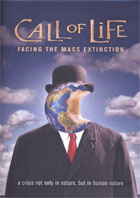
Call of Life: Facing the Mass Extinction 2010
Distributed by The Video Project, PO Box 411376, San Francisco, CA 94141-1376; 800-475-2638
Produced by Chera Van Burg
Directed by Monte Thompson
DVD, color, 60 min.
Jr. High - Adult
Science, Biology, Environmental Studies, Evolution, Anthropology
Date Entered: 11/03/2010
Reviewed by Justin Cronise, Genesee Community College, Batavia, NY and Brighton Place Library, Tonawanda, NYCall of Life: Facing Mass Extinction is a beautiful and informative film that is also a call to action. With alarming data about the Earth’s rapidly dwindling plant and animal populations—and the skyrocketing rate of extinction—this film tells us that we as humans have to change the way we are living. We have a choice: continue to exploit and take our life-sustaining environment for granted until it collapses, or start taking the necessary measures to reverse the negative impact that humanity inflicts upon the environment. It is a powerful and compelling message, describing a far-reaching crisis in nature and also in human nature. As an expert notes in the film, humanity has never been faced with a challenge on such a global scale.
Call of Life features in-depth analysis with thought-provoking interviews of articulate scientists, environmentalists, and visionaries. A much-abbreviated list includes paleo-anthropologist Richard Leakey (author of The Sixth Extinction), biodiversity expert Norman Myers, conservation scientist Stuart Pimm, ecologist Gretchen Daily, biologist Brock Dolman, environmental activist Derek Jensen, and eco-philosopher Joana Macy.
The film is also visually striking and features gorgeous nature footage, much of which comes from excellent stock footage or visuals from numerous nature photographers and filmmakers. There is a group of modern dancers/performance artists who provide an interesting layer of evocative imagery. With the expert voice of actor/activist Peter Coyote, the narration blends seamlessly with the rest of the content. The film has high production quality, is well-organized, and is both emotionally and intellectually engaging.
While Call of Life celebrates the glorious diversity of nature and species, there is at the same time a deep sadness with the anticipation that so many species (even just those scientists have discovered) are going extinct each day, and one may feel the helplessness of the slippery slope and the mounting crisis that affects not just the plants and animals around us—but our own species as well. One may well ask, is this a film about saving the tigers or about saving ourselves? Also, is this just another film on climate change? The crisis in biodiversity is a fascinating aspect of the global environmental crisis in which climate change plays a critical factor, but the solutions are essentially the same. The difference here is that the extinction of the human species is on the line.
Call of Life is another valuable addition to a growing group of excellent documentaries about the effects of humans on our natural environment, with added depth supplementing mainstream advocacy films such as Gore’s An Inconvenient Truth or DiCaprio’s The 11th Hour. Call of Life is highly recommended for essentially all audiences, and would be a welcome addition to collections in most high school libraries, public libraries, and undergraduate academic libraries.
Awards
- Best Science Communication Film, Reel Earth New Zealand Film Festival, 2010
- Humanitarian Award , Accolade Competition
- Award of Excellence, Accolade Film Awards
- John Muir Award, Yosemite Film Festival
- Finalist Award/Film, International Wildlife Film Festival